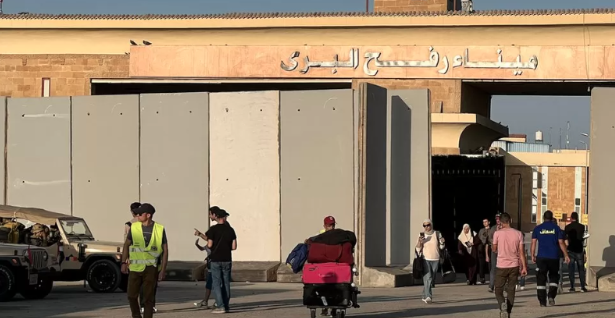Israel
Rafah’s Closure Amid Israel War: Desperate Gazans Wait

Under the blistering sun, the Rafah border, a junction of despair and shattered dreams, stands desolately closed amidst the escalating tensions of the Israel war. This gateway between Gaza and Egypt, once a corridor of relief, now echoes with the stifled dreams of those trapped by its closure. The unexpected sealing of this critical passage has arrested the flight of foreign nationals and the transport of the wounded, casting a shadow of distress across the strip. Amidst the turmoil, hundreds find themselves ensnared in an unsettling stalemate, their fates hanging in the balance as diplomatic enigmas exacerbate the humanitarian crisis at the crux of the Gaza strip’s plight.
Rafah, the solitary southern valve for human movement in and out of Gaza, has a history fraught with openings and closures, each with its own narrative. Yet, this recent closure seemed to carry the weight of history with it, resonating with tales of past sieges and blockades that have defined the strip’s grim heritage.
Gaza’s chronicles are laced with the frequent draw of battle lines, the demarcation of territories, and the clash of wills between powers. The current cessation at the Rafah crossing is but an echo of the long-standing Israeli-Egyptian blockade, a strategy with roots deep in the soil of conflict that has long besieged the Palestinian enclave.
Beneath the motionless gaze of abandoned checkpoints, tales of displacement and yearning echo. Mohammed Ghalayini, a British scientist ensnared by the harsh discord of conflict, shares his witness to the tribulations at Rafah. His sojourn into the heart of this besieged land mirrors a collective narrative etched with the struggle for passage and the longing for a semblance of the familiar.
The scenes he relays are poignant in their simplicity and their sorrow: families, once content in their daily rhythms, now forge paths of exodus toward uncertain futures, their meager possessions piled atop donkey carts, a stark visual anthem to the desperation of the moment. There is a somber unity in this procession—each member bound by the fragile threads of hope and the tenacity of the human spirit.
Within this austere landscape, local life persists, altered yet unyielding. As Ghalayini notes, the instinct to endure weaves through the community, spurring inventive means of coping: a marketplace still brims with haggling voices, children fashion play from the remnants of their fractured reality, and amidst it all, a collective resilience flickers, as enduring as the land itself. Here, in the poignant resilience of Rafah, lies an untold story of adaptability and an undying quest for a dawn less fraught with sorrow.
This standstill at Rafah is not merely an isolated event; it is a microcosm of the broader power play at work in the region. The Gaza Strip, a land marred by contention, finds its fate perpetually hanging by the thread of geopolitics. This recent cessation at Rafah underscores a persistent struggle for autonomy and survival within the larger saga of the Israeli-Palestinian conflict.
The siege mentality that grips Gaza is palpable, as is the resilience of its people. Yet, the underlying currents of control, the strategic maneuverings of governments, and the often-unseen machinations of international diplomacy bear down with an invisible yet crushing force.
The prevailing narrative, as silent as the closed gates, leaves a vacuum where questions echo unanswered. With no official statements forthcoming, the opacity of the situation only deepens. The accounts from Palestinian sources about the halted movement of foreigners and injured patients cry out for transparency and beg a critical eye to discern the unspoken realities at play.
The stark dichotomy between the official silence and the urgency of humanitarian needs invites scrutiny. While international entities like the UN call for essential supplies to alleviate the suffering, the measures and responses remain mired in complexity.
Visualize the scene: the Rafah crossing, once a conduit of passage, now a cul-de-sac of despair. The landscape is one of dire contrast—a bustling checkpoint now eerily quiet, save for the whispers of those stranded, their faces etched with the fatigue of waiting and the anxiety of an uncertain future.
The border, typically a nexus of transition, takes on a surreal stillness, punctuated only by the occasional rustle of papers—passports that remain un-stamped, documents of identity that fail to fulfill their promise of passage.
As the saga at the Rafah border crossing unfolds, the cessation of movement poses a poignant query: When will the gate once again swing on its hinges to offer passage to the waiting? The collective yearning for an answer mirrors the larger aspiration for resolution, for a day when the free flow of people and aid is restored.
As history bears witness to the resilience of the Gazan spirit, the silent siege at Rafah’s gates lingers as a stark reminder of the challenges that lie ahead. The narrative of Gaza continues to be written with the ink of adversity, and yet, the quest for a chapter of peace remains undiminished. The question that persists as the world gazes upon Rafah is not just one of when the crossing will open, but of when the doors to a lasting dialogue for peace will finally be unlocked.












You must be logged in to post a comment Login